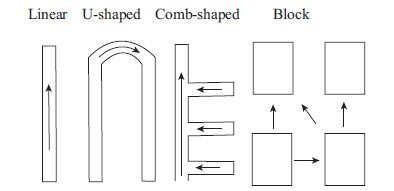Types of Layouts :
(1) Flow Forward Layout
Materials are taken from a position behind and to the left of each operator, who then places the processed good on the front table for the next operator. This method is suitable for large production lots where each operator uses a few tools (Figure 1).
(2) Reciprocating flow
In this model products flow from left to right or right to left. This layout allows the operator to move more quickly while working on multiple machines at once (Figure 1).
 |
| Fig. 1 : Flow forward and side-to-side flow layouts |
Some general layouts depend on the map of factory buildings and production systems as shown below.
1. Linear
The sewing area is in the middle of the floor with cutting and finishing areas at both ends of the sewing line (Figure 2).
2. U-shaped
This layout is suitable where materials are supplied and finished goods are received through the same location.
The parts production center can be placed inside the U.
The same worker(s) can therefore handle both supplying materials and taking the finished product away from the line. So the easier products to supply materials at the same rate come off the line and thus maintain a constant number of products (Figure 2).
3. Comb shaped
The plural is achieved by combining linear lines, the lines of each part are also linear, and the lines of the parts are connected to the main line where the parts are needed (Figure 2).
4. Block
Plural units are combined to form individual blocks, each of which has the required sewing machine. This layout is suitable for organization by production groups or for semi-permanent layouts for small lot production lines where products change frequently (Figure 2).
 |
| Fig. 2 : Layout types |
Objectives of Layouts:
The purpose of equipment layout is to have all production equipment reasonably placed for maximum efficiency based on flow configuration charts. Some helpful hints are outlined below.
1. First, set the location of the aisles and the entry and exit points of materials.
2. Remember that the work area is a three-dimensional space. Use the entire space for maximum efficiency.
3. Consider the atmosphere and comfort of the work environment.
4. Clearly define the main flow (body).
5. When the product being manufactured changes, the layout may need to be changed. Remember to make the layout flexible and easily adaptable to new needs.
6. Keep it simple so that the process is easy to manage and watch.
7. Avoid moving materials and products backwards in line or across other paths. Arrange equipment so that materials and products are transported the shortest possible distance and as few times as possible. Arrange transport routes to follow the flow of production, so that operators do not need to transport goods.
8. Use work table extensions and holding tables to smooth the flow.








0 Comments